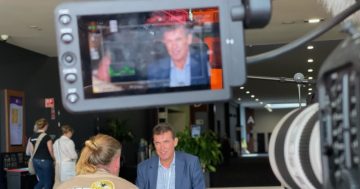
Back Up delves into how back pain is the biggest cause of disability worldwide, and the revolutionary way scientists think about pain. Photo: Supplied.
Low-back pain is the No. 1 cause of disability worldwide. When it comes to treating chronic back pain, is medicine helping or harming patients? This is a noteworthy question, raising red flags about how we experience pain and the chosen ways of treating it.
Leading experts say more often than not, it is the Western world’s cultural beliefs that put us where we are, and all the expensive medicine is making things worse. Back pain is one of the greatest problems in world health today … and one almost entirely of our own creation.
Award-winning journalist Liam Mannix lives with back pain and has gone to great lengths to look for the source of a pain ‘’epidemic’’ that is sweeping Australia. What he has uncovered is an eye-opener, illustrating that our backs are strong and capable, thrive on movement and that recovery from back pain is within our control.
One in five Australians has chronic pain, which ranges from headaches to arthritis and endometriosis. Chronic back pain is a subset of the even-wider problems of chronic pain, which overall is the largest cause of disease and disability worldwide. They have many differences and similarities. They also present a growing threat, with GP presentations for chronic pain up 67 per cent in the past decade in Australia.
In Back Up, Mannix has taken his own experience as a starting point for this persuasive and vital work. Once he started to look more into this, he was intrigued by back pain and a strange theory that had started to emerge in the past 20 years.
“One suggested both doctors and society at large had gotten the way we think about back pain, and pain in general, all wrong,” Mannix said.
“This radical theory suggests that much pain is driven in part not by anything wrong with our backs but something wrong with our culture and our ideas and how we think about pain. An idea as a virus. A social disease.”
Another viewpoint, in the foreword from Professor Chris Maher from the University of Sydney, offers “hope and a way forward out of this mess”.
“It provides people with back pain the knowledge they need to navigate a complex health system so that they are more likely to receive the right care and recover,” Professor Maher says.
“While we now have a good understanding for how low-back pain should be managed, many people with this condition continue to receive poor healthcare – either missing out on recommended treatments or receiving treatments that are discouraged. And this confusing state is super expensive.”
Low-back pain affects more than 500 million people at any point in time. In Australia, it costs the Australian health system $4.8 billion annually. It’s the most common health reason forcing middle-aged Australians to retire early.
Mannia walks us through the myths and misunderstandings about low-back pain, exposes how vested interests have conspired to create an epidemic of poor care, and clarifies how much suffering this ‘’epidemic of poor care’’ has inflicted on individuals and society.
A course of action is available. Mannix uses the science, and the examples of his father’s and his own back pain, to illustrate that recovery is within our own control. For people with back pain, the author provides the knowledge they need to navigate a complex health system so they are more likely to receive the right care and recover.
He covers the new science of pain – and how we think about and conceptualise our pain – opening the way for new ways of viewing and managing this discomfort. Our backs are strong and capable and they thrive on movement.
Back Up begins with personal stories, then looks at the back itself, and some of the common knowledge about our backs that can be viewed as being wildly off base.
Several expensive back pain treatments are investigated, science is looked at, we meet people who have gone under the knife and hear their stories. This is the old science of back pain. New science is the focus of the second half.
“How neuroscience has revolutionised the way scientists think about pain and what that can tell us about sore backs. How the crucial connection between brain and back can break down, and how to rebuild it.”
Last, we tour rehabilitation approaches with the “best evidence behind them, to see how we can all build stronger, pain-free backs”.
Back Up, by Liam Mannix, NewSouth Books, $34.99






